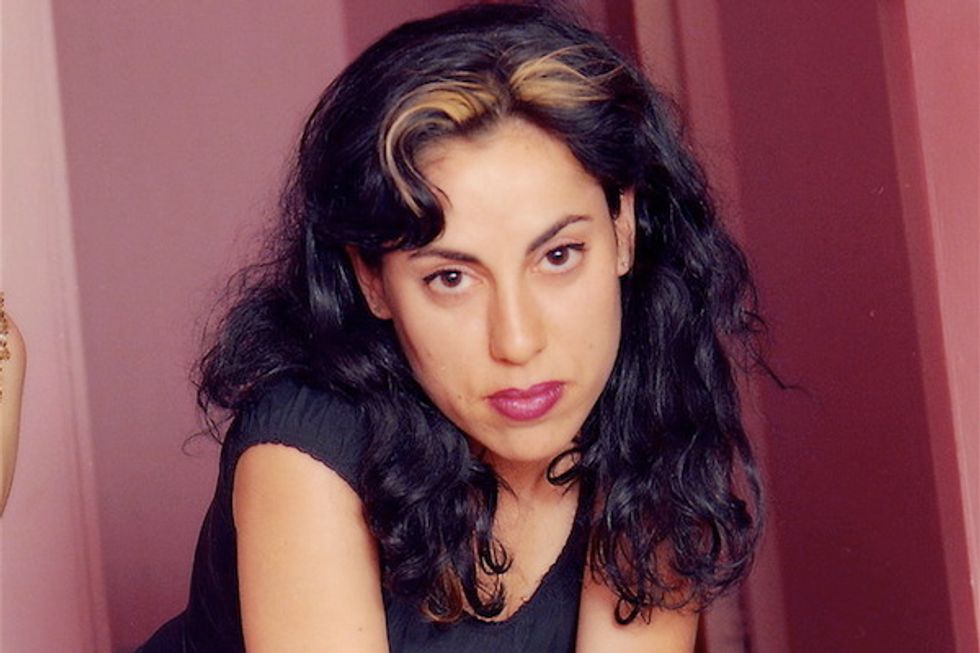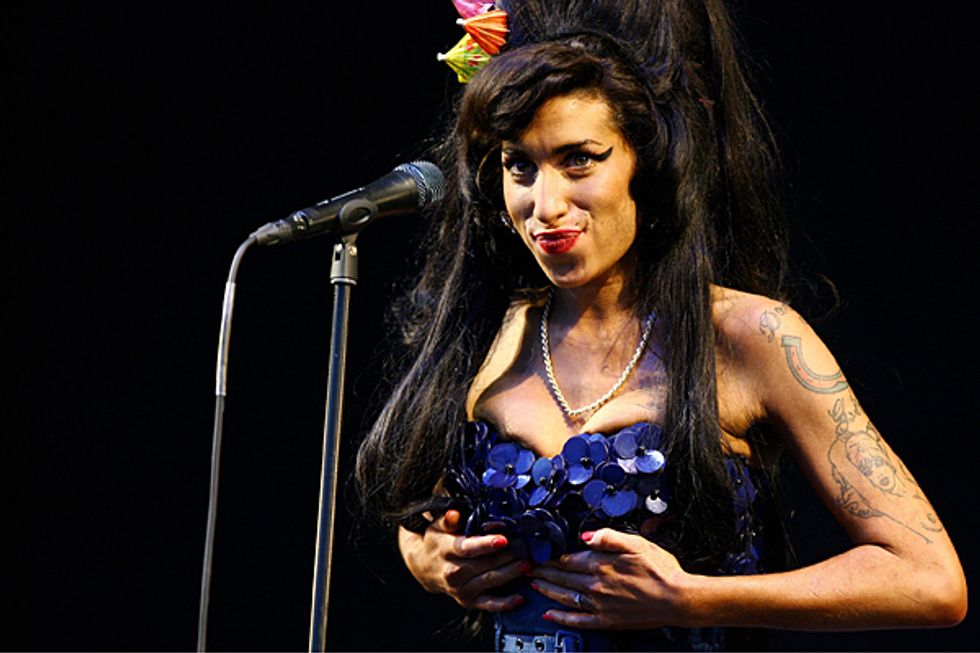Behind every diva is a family. Even such a diva as Amy Winehouse who, sadly, is often remembered mostly for the flash and scandal of her final days. “Amy Winehouse: A Family Portrait,” which opened at San Francisco’s Contemporary Jewish Museum on July 23 and was created in collaboration with her brother, Alex Winehouse, and the Winehouse family, shines an all new light on the musician and her work, focusing on her young life and the family’s history. This may come as no surprise, but San Franciscans will also find plenty of common ground: Amy Winehouse was a lot like us.
“The charm of this exhibition is that it focuses on her early, private life and her family roots,” says the museum’s director, Lori Starr. Inside the CJM’s galleries, you’ll find Winehouse’s own record collection. Her guitar. Her suitcase full of photographs, the same one she went through with her father just days before her death from alcohol poisoning (on July 23, 2011, exactly four years before the opening of the CJM exhibit) at the heartbreaking age of 27. The exhibit originally debuted and was curated by the Jewish Museum London, and has since traveled to Vienna and Tel Aviv. Significantly, San Francisco is the show’s only U.S. stop. You see, Amy Winehouse was a complicated woman—her eclecticism, rebelliousness, her sometimes-hidden histories, and that pour-your-heart-out talent. San Francisco understands complicated. Winehouse resonates here.
“She was beyond style,” remembers former SF Weekly music editor Jennifer Maerz, who saw Winehouse play South by Southwest back in 2007. In her review of the show, Maerz wrote, “the British bad girl's soulful diva delivery deserves every accolade it attracts.” Musically, Maerz now points out, “She was kind of on the border of a lot of things.” In fact, she would have fit right in with SF’s independent music scene. “She could have played Bottom of the Hill, where it’s a little bit more in your face and rock ’n’ roll.” Or, “she would have fit in with Shannon and the Clams, or Hunx and His Punx and that kind of garage-y punk world,” says Maerz, naming two great local acts who’re highly influenced by 1960s girl groups and soul sounds, but whose aesthetics are rough, a little scruffy. But on the other hand, she also would have had a lot in common with the more grown-up Dusty Stax band. “They probably all have a similar record collection,” Maerz says.
At the CJM exhibit, fans can check out that very record collection, full of Count Basie and Sarah Vaughan, Dinah Washington, Ray Charles, Stevie Wonder, and Frank Sinatra. They’ll also hear, playing in the galleries, songs from a playlist handwritten by a teenage Winehouse. It’s titled “Songs on my Chill-Out tape,” and its mishmash of styles shows a disregard for boundaries between musical genres that might seem familiar: Ella Fitzgerald, the Offspring, the Platters, Luscious Jackson, Julie London, the Skyliners. Assistant curator Pierre-Francois Galpin says the tape plays a big part in shaping the show, along with an essay Winehouse wrote at about the same age, excerpts of which appear on the walls.
Northern Californians appreciate Winehouse’s mix of visual influences, as well. “She was influenced by a lot of people I really love,” says Shana Astrachan, a makeup and hair artist whose six-year-old company Fox and Doll operates out of a sunlit mini lounge on 18th Street and specializes in vintage looks. Astrachan’s clients come for lessons—her most popular classes, revolving around cat eyes, red lips, and hair teasing, add up to pure Winehouse. Sometimes clients even specifically request an “Amy Winehouse style.” “It’s a real feminine rebel look,” says Astrachan, a huge Ronnie Spector fan, who connects it to the beginnings of feminism and a certain kind of power. Although most modern Bay Area women want a more toned-down version of the look, it continues to resonate among the many feminine rebels who make San Francisco what it is.
One such woman, local singer Karina Denike, channels Winehouse’s strong-minded confidence and may have even influenced Winehouse herself early on. Denike is a Londoner who came to the Bay Area to front the punk-ska band Dance Hall Crashers in the early 1990s. The first thing most will notice about Denike is her remarkable likeness to Winehouse. They look alike. They sound alike. “We’re both Jewish girls with dark hair who grew up in working-class neighborhoods in England,” Denike says, and both gravitated musically toward the same things: 1960s soul, American jazz vocalists, punk, ska, and rocksteady.
(SF singer Karina Denike, who bears a striking resemblance to Winehouse and who may have been an influence on the star before she was famous, will perform at Amy Winehouse: The Singles, a tribute concert at the CJM on Aug. 13 and 16. Photo courtesy of Karina Denike.)
“I was performing in London in ska/punk bands—with this same eyeliner I've worn since I was 14—when [Winehouse] was a teenager. It's highly likely that she even saw my band play then; it’s a small scene. You just never know,” says the Bay Area musician, who has shared stages with the likes of the Pretenders and the Ramones. “I was doing this, and looked like this, way before I knew she existed.” It’s a brash thing to say, almost shocking. It’s also a lot like something Winehouse would have said. “She was described as a troublemaker in school,” says the exhibition catalog, to no one’s surprise. Here in SF, where we can now view pictures of Winehouse as a teenager, we can imagine her possibly breaking curfew, maybe slipping out of the house, shoes in hand, to go see the Dance Hall Crashers.
On August 13th and 16th, an Amy Winehouse tribute concert takes the stage at the museum, featuring three Bay Area acts: Denike, California-soul group Midtown Social, and flamenca band LoCura. In a surprising twist, the show will not focus on Back to Black, Winehouse's most famous album. Instead, it will explore the exhibit’s theme even further via Amy Winehouse's singles.
“We thought it was important to depict the journey of her musical career, and not dwell on how the media portrayed her at the end,” says Lyz Luke of UnderCover Presents. Rather, the show will aim to uncover the more innocent side of the musician, “as a good Jewish girl from England.” The concept dovetails with the exhibit’s theme of “A Family Portrait,” a big part of which is the family’s history as Jewish immigrants. The exhibit takes into account the religious, cultural, and historical aspects of Winehouse’s life that reflect the experiences of so many Jewish families whose ancestors fled Eastern European pogroms. Were it not for Harris Wienhause’s escape to London in 1891, we likely wouldn’t have ever had Amy Winehouse.
The story is deeply American, though, notes director Starr, emphasizing that Americans all came from somewhere else, and that although it’s a Jewish-immigrant narrative, it’s also a universal one. “We all want to know where we came from,” she says, “This early history of her family is one that a lot of families will share.” So while the UnderCover concert may not feature folksong from the old country, exactly, it will expand the idea of Winehouse’s musical contribution, complicating her music instead of merely paying homage to its most popular tracks.
(This blue sequined Luella Bartley dress, worn by Winehouse at the Glastonbury music festival in 2008, is on display at the CJM exhibit. Photo via MTV)
In contrast to its gritty historical elements, the exhibition also has plenty of glamour: gowns, such as the sequined blue Luella Bartley dress she wore at Glastonbury in 2008, and heels—very high, very sparkly, and very expensive. The garb brings to mind another very San Francisco art form: drag. SF drag performer Amy Bathhouse is unequivocal on the subject of her character’s inspiration: “I chose to name myself after Ms. Winehouse because of how much I relate to her story,” says the thoughtful, outspoken lip-syncer. Originally from Philadelphia, Bathhouse doesn’t always appear styled as Winehouse, but no matter which wig she wears, “I keep my perception of Amy Winehouse's spirit alive in Amy Bathhouse....She really just was her own person, dancing to a rhythm no one else could hear.”
So the parallels pile up. We have the same record collections. Our hair may be smaller and our eyeliner wings shorter, but feminine rebels of all genders remain outspoken—and complicated—in San Francisco. In “A Family Portrait,” we’ll see our immigrant stories and the way we mix them, the way we’re influenced by them, and the way we refuse to follow their rules sometimes, alongside Winehouse’s own. UnderCover’s Luke puts it best: “The Bay Area is a place where people feel comfortable being themselves, and unabashedly so. I feel like Amy really owned that.”
And more importantly, on a larger scale, Starr reflects that the exhibition does specific work of its own. “I always felt that Amy Winehouse’s very sad final years have overshadowed her achievements in music. In some sense this exhibit sets that right.”
“Amy Winehouse: A Family Portrait” continues through November 1. A number of related events are scheduled, notably noontime Gallery Chats by Don Ed Hardy and Greil Marcus. Two local artists, Jennie Ottinger and Jason Jägel, have contributed original work inspired by the singer’s life, and several other artists also contribute to a concurrent exhibit called “You Know I'm No Good.”
// Contemporary Jewish Museum, 736 Mission St (SoMa), thecjm.org























